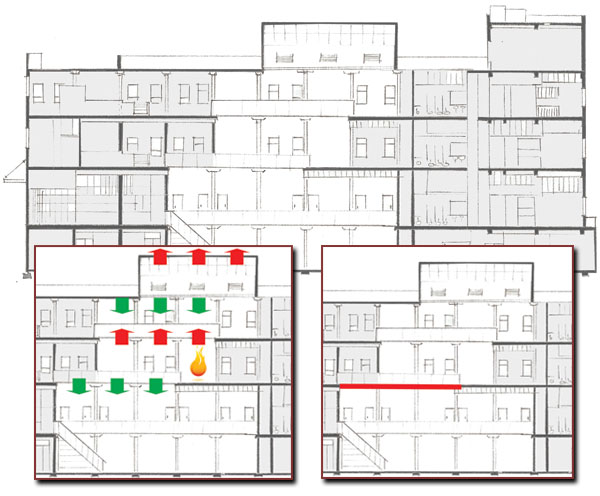Fire and Smoke Curtains: Meeting Atrium Code Requirements
Automatic Sprinkler Systems
Sprinkler systems are de rigueur in response to the IBC code requiring an approved automatic sprinkler system be installed throughout an entire building—including atrium designs (one exception is when that area adjacent to or above the atrium is separated by a 2-hr. fire-resistance fire-rated barrier or horizontal assembly, or both).
Sprinkler systems are designed to control a fire, not to extinguish it. It is therefore likely that significant quantities of smoke may be generated that can travel far from the initial fire source. Since sprinkler systems are not sufficient to protect an atrium from potential smoke migration—codes require the addition of a smoke management system.
Case Study 1: Use of Horizontal Flexible Smoke Curtain in Open Plan Office |
This case study demonstrates that multiple components of a mechanical smoke control system could have been replaced by a single passive horizontal smoke control curtain at considerable cost savings. A four-floor office building was renovated to include a series of floor openings. A skylight extended above the center of the third floor in the area above the atrium opening. Height from the ground floor to skylight was approximately 53 ft. The floor openings were offset and did not line up vertically to provide a typical atrium configuration. This made it difficult to maintain smoke at least 6 ft above the highest occupant. A tenability smoke exhaust control system was therefore proposed based on performance-based requirements developed using a modeling approach. The intent of the design was to exhaust smoke from the floor containing the fire and from the skylight, also to exhaust smoke that might spill into the atrium. Supply/make-up air was delivered to the two non-fire floors. For a fire directly beneath the atrium opening where smoke would rise unimpeded up into the skylights, beam detectors in the skylights aligned the system to exhaust the uppermost third floor in conjunction with the skylight exhaust. The skylight exhaust and floor exhaust were accomplished using new, dedicated mechanical equipment. The supply air was provided via a combination of new, dedicated equipment and existing equipment that was also used to provide normal HVAC. For this project it would have been possible to replace the entire smoke exhaust system by a single horizontal 2-hr. flexible fire curtain at the second floor slab. This would separate the building into two 2-story connected spaces, neither of which would require active/mechanical smoke control. The size of the opening was nominally 20 ft x 60 ft. Activation of the flexible fire barrier would be via the fire alarm control panel upon smoke detection or sprinkler water flow. Mechanical Smoke Control System Required:
Passive Smoke Control System:
|
 |
Top: Cross-sectional view of office showing offset configuration of floor openings; Bottom left: Smoke exhaust control system design; Bottom right: Horizontal flexible smoke curtain at second floor |









